ANSC 300 Thermoregulation
1/34
There's no tags or description
Looks like no tags are added yet.
Name | Mastery | Learn | Test | Matching | Spaced |
|---|
No study sessions yet.
35 Terms
Heat vs. Temperature
***heat and temperature are NOT the same***
Heat: total energy of all molecules, measured in joules (is transferred to an object; ex.- how the stove heats the pot)
Temperature: avg. kinetic anergy of molecules in a substance measured in F, C, K (how hot or cold an object is)
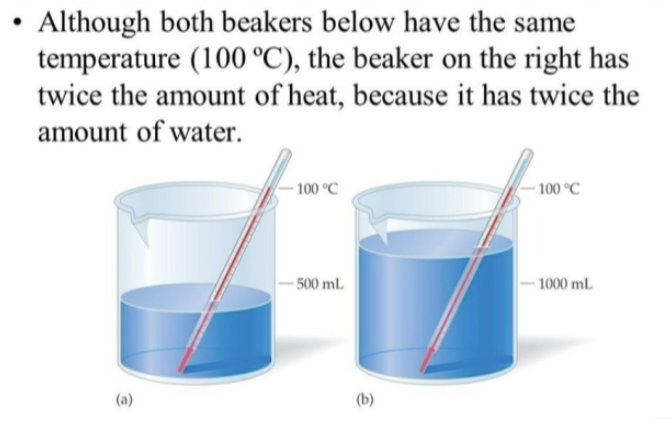
HOMEOtherms
mammals/birds
temp stays constant
ENDOtherms: rely on internal heat
POIKILOtherms
reptiles
temp varies
ECTOtherms: rely on external heat
What is the Average Temperature of Most Domestic Animals?
97.7 - 103.1 F
Core vs. Rectal/Skin Temperature
Rectal Temp: represents a true steady state of temperature because it reaches equilibrium more slowly
Core Temp: “deep body temp”; higher than the temperature of the limbs or even higher than the temperature observed rectally
Factors:
exercise
time of day
ambient temperature
digestion
hydration
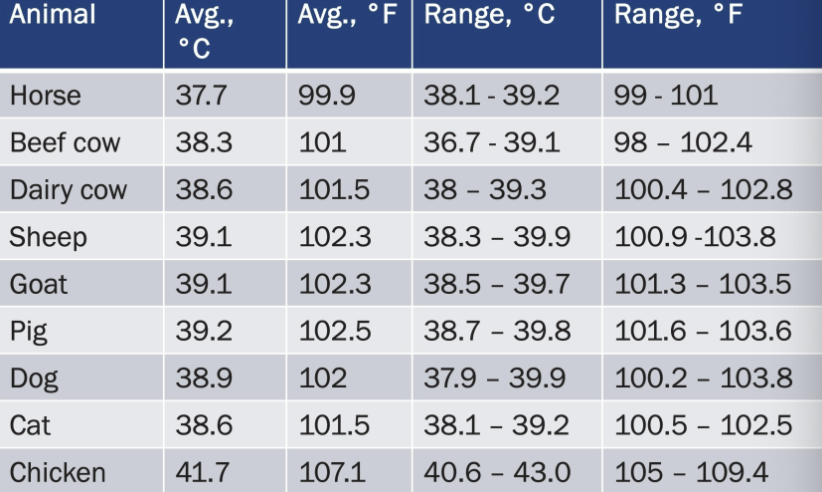
Diurnal Temperatures
variations in temperature that are related to the time of day
animals that are ACTIVE during the DAY and SLEEP at NIGHT have body temperatures that are lower in the morning than in the afternoon.
the opposite is true for nocturnal animals
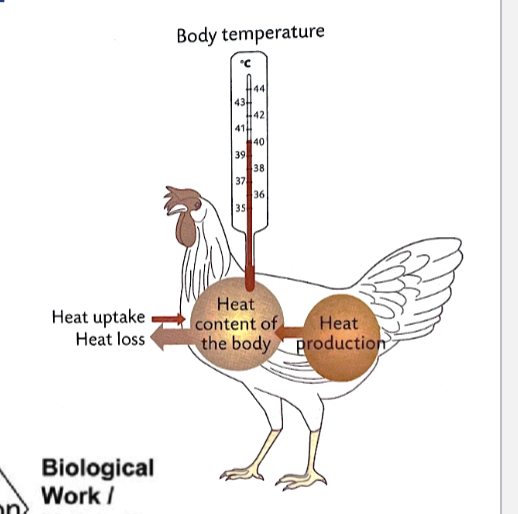
Heat
is a byproduct of all metabolic processes, and moves down a gradient
important for core body temp in endotherms
created by both ATP production and use
heat loss is important to maintain body temp!!

At Rest, the Majority of Body Heat is Produced in a Few Key Locations Such As _________
Kidneys: 0.5% of body mass ; 7% of heat production
Heart: 0.5% of body mass ; 9% of heat production
Lungs: 1.0% of body mass ; 4% of heat production
Brain: 2.0% of body mass ; 18% of heat production
Liver: 2.5% of body mass ; 26% of heat production
SUM of HEAT PRODUCTION: 64 ——- SUM of BODY MASS: 6.5
Skeleton & Muscles: 42.0% of body mass ; 26% of heat production
Skin: 7.5% of body mass ; 2% of heat production
Other: 44.0% of body mass ; 8% of heat production
SUM of HEAT PRODUCTION: 36 ——— SUM of BODY MAS: 93.5
***When will the Skeletal Muscles Generate more Heat?***
shivering
exercise
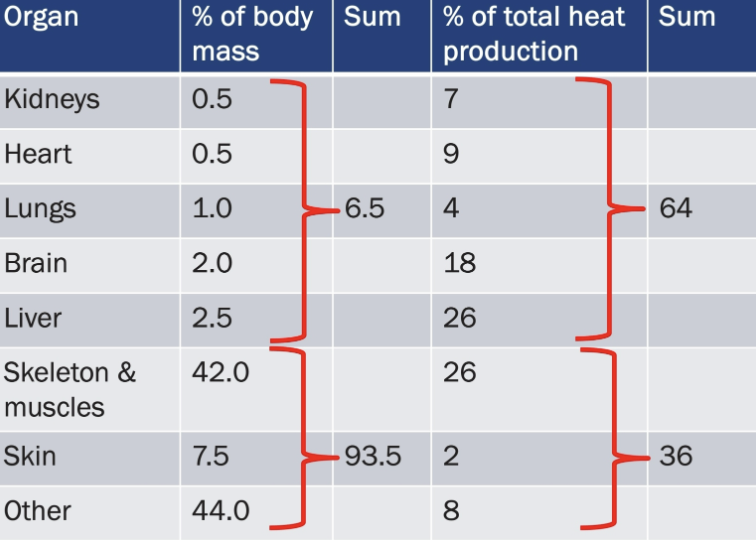
____________ and ____________ are Correlated.
Body Size & Heat Production/Loss
metabolic rate is linked to heat production!
BROWN Fat
is metabolically active and creates body heat
Who Has It?
certain newborn animals
animals that hibernate
LOCATION: mostly around the scapula & kidneys
metabolically different and more active than white fat; Why? — Because it has more mitochondria
What Hormones Aid in Heat Production?
Epinephrine & Norepinephrine
increase metabolism
are the stimuli for increased metabolism of brown fat
Thyroid
increases during cold periods
How do we Remove Heat Produced from the Body?
Respiratory System: helps remove excess heat from the body through breathing
Circulatory System: removes heat from the body through vasodilation, heat dissipation, sweating, and vasoconstriction
Digestive System: doesn’t DIRECTLY remove heat from the body, BUT it occurs with digested food, then it gets circulated, and then the hypothalamus dissipates the heat
Circulatory System
is important for dissipating heat
the sympathetic system regulates the vessel diameter
Heat Loss
Heat Conversion
_____ ______ is Brought to the Surface of the Body, to be Lost to the Environment.
warm blood
sympathetic system
Arteriovenous Anastomoses
direct connections between arteries and veins that shunt blood to superficial veins
shunting is important in regulating body temperature and occurs in areas like the skin of the hands and feet

Exchange of Heat Between the Body and the Environment Occurs in Many Ways Such As ____________.
Radiation: transfers heat through electromagnetic waves
Conduction: transfers heat through direct contact
Convection: transfers hat through the movement of fluids
Evaporation
***All heat exchange follows a heat gradient***
Radiation
involves the heat that is emitted between the body and environment
can gain and lose heat via radiation
Daytime: Sun #1
What Else is Outside?
farm buildings, coat color
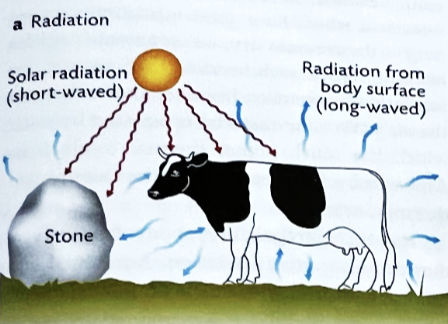
Conduction
requires direct contact to exchange heat
can gain and lose heat via conduction
Thermal Conductivity: how easily heat is conducted
Low: air, gases
High: metals
Farm buildings
Surgery?
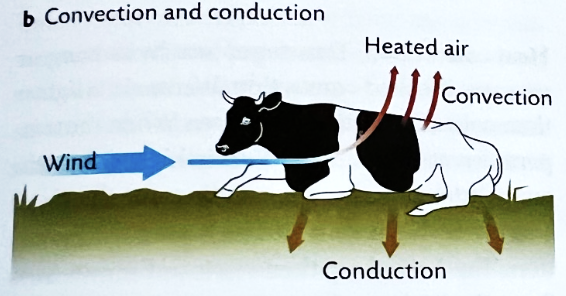
Convection
transfers heat via moving air or water
can gain and lose heat via convection
natural vs. forced convection
NATURAL: any fluid motion caused by natural means such as buoyancy
FORCED: fluid is forced for flow over a surface or in a tube by external means
wind chill!
fans
transportation?
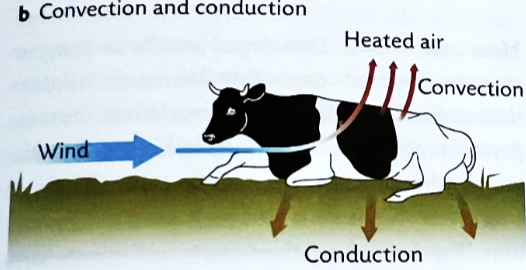
Evaporation
involved the conversion of water to vapor
can ONLY LOSE heat via evaporation
Insensible Water Loss: airway and skin
not part of thermoregulation
Thermoregulation:
sweating
panting
wetting of body surface
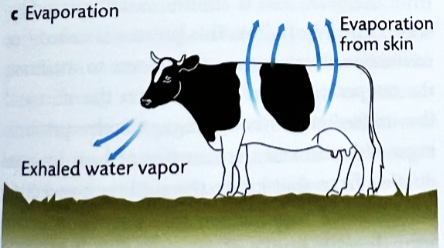
Thermoneutral Zone (TNZ)
shows where animals become stressed due to heat loss/gain
where heat production and heat loss are canceling each other out (they’re equal)
ex.- homeostasis
UCT (right side): heat stress, HYPERthermia, metabolic rate increases to dissipate excess heat
LCT (left side): cold stress, HYPOthermia, metabolic rate increases to generate more hear
TABLE
Beef Cattle & Dairy Cow= UCT(77,25) & LCT(32,0 , 60,15 , -22,-30)
Sheep & Lamb= UCT(88,31) & LCT(72,22)
Horse= UCT(86,30 , 68,20) & LCT (41,5 , 5,-15)
Dog= UCT(86,30) & LCT(59,15)
***Animals are more comfortable at colder temperatures***
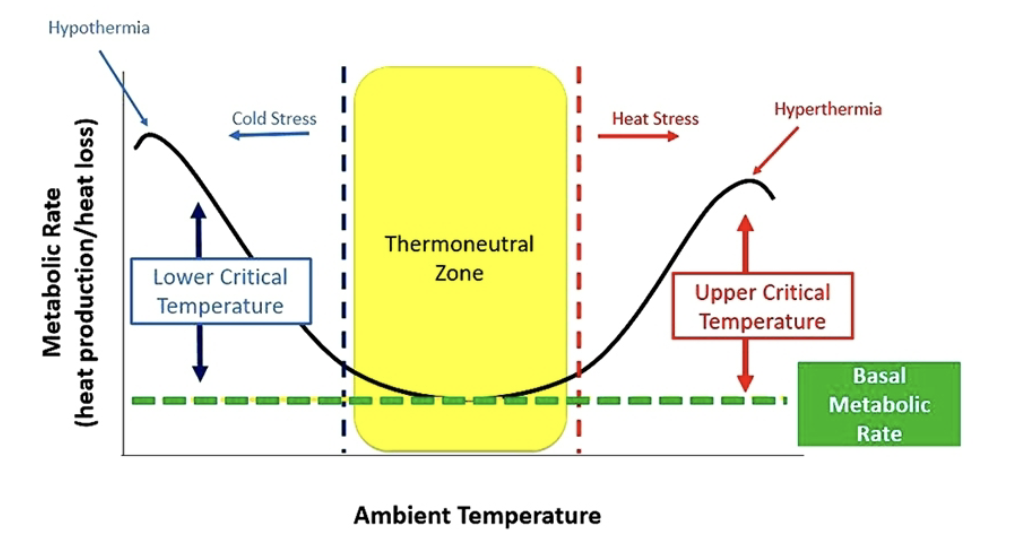
The ______ the animal, the _______ the Metabolic Rate Per Unit Weight.
smaller; higher
Thermosensors
monitor changes in body temperature
Skin
cold, hot
Body Core
Hypothalamus
Hypothalamus
is the *thermostat*
Sensory Input
Warmth and Cold Sensors In: skin, internal organ, hypothalamus
Motor Output
Heat Stress: behavior, increased skin blood flow, sweating, panting
Cold Stress: behavior, reduced skin blood flow, shivering, activation of brown adipose tissue, hormone secretion
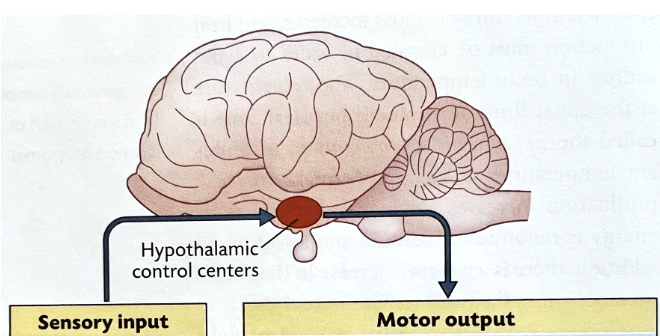
There are More ____ _________ than Hot Receptors on the Skin
cold receptors
When Temperatures RISE, We are ABOVE the _______
UCT
vasodilation blood vessels
more blood to skin
sweating
panting
behavioral changes
ex.- reduce activity, drink more water, eat less
Vasodilation & Vasoconstriction is a _______ ________
localized response
NOT systemic
At Higher Environmental Temperatures, __________ is Used More.
evaporation
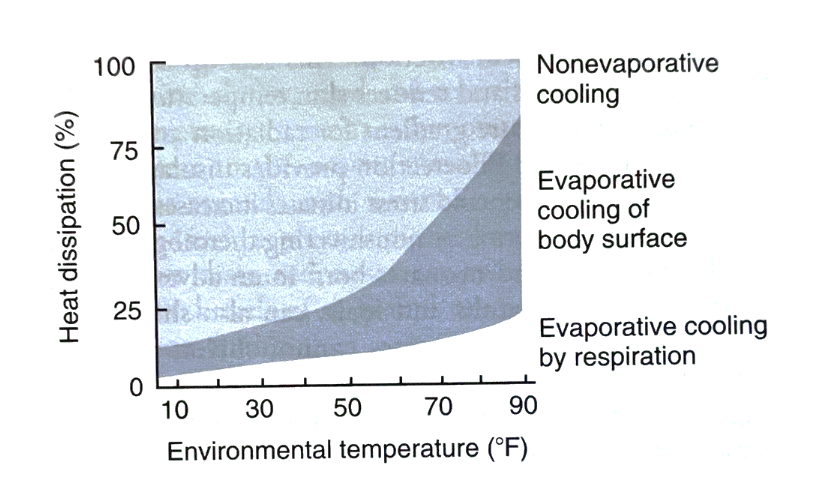
Sweating
is important for horses and cattle (and us too!)
Apocrine Gland: hoofed animals; is linked to a hair follicle
Eccrine Gland: primates; is NOT linked to a hair follicle
Sympathetic system
Dogs & Pigs: not important
***When Might Sweating Not Work As Well?***
when it is super humid outside, our sweat slowly drips off our body and our body’s cooling system becomes hindered in a humid and hot environment → biggest risk for heat stress/hyperthermia.
Panting
is vital for dogs to lose heat (also ruminants, cats, birds)
Dead Space Ventilation: space where gas exchange doesn’t occur
Horses & Pigs: not important
When Temperature DROP, We are BELOW the ______
LCT
vasoconstriction blood vessels
less blood to the skin
shivering
BAT (brown adipose tissue)
hormone secretion
behavioral changes
Behavioral Adaptations to Cold
huddling
curling up
piloerection of hair
body adjustments
plumage “fluff”
______ ________ and _________ are Inversely Related.
Thermal Conductivity & Insulation
***What Happens if an Animals Gets Wet?***
they will lose heat more rapidly (bad in winter, good in summer)
Fever
elevates the normal setpoint of temperature → pyrogens are to blame!!
defense mechanism against microorganisms
Pyrogen: substance that causes fever
***How Does the Body React to Adjusting the Setpoint?***
illustrated on graph
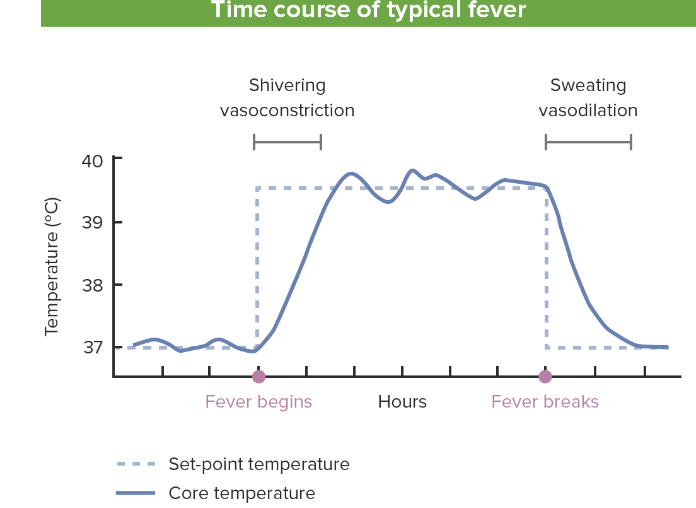
Pyrogen
can be exogenous and endogenous
prolonged high fevers can cause damage
above 41 C, 106 F
Prostaglandin E: mediates fever response
Hypothermia
>25 C or 77 F; usually fatal
Exception
Hyperthermia
heat stroke
43-44 C or 109-111 F; usually fatal